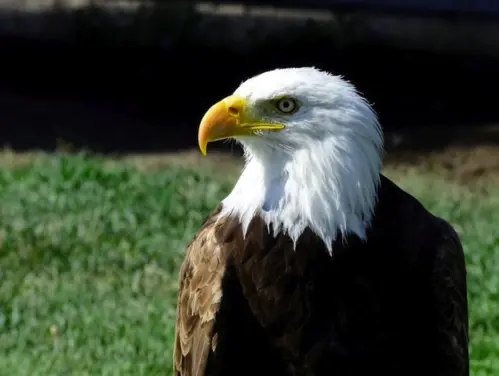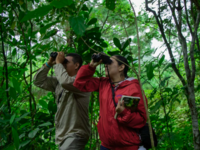On this page...
Bald eagles have a wingspan of 6 to 7 1⁄2 feet. The sexes are alike, with the female being slightly larger. Bald eagles sit 3 to 3 1⁄2 feet tall and weigh 8 to 15 pounds. Their eyes are 5 to 6 times more powerful than human’s.
Back to topHistory & Population
The Greek interpretation for the bald eagle’s scientific name (Haliaeetus leucocephalus) is sea eagle with white head. In colonial times bald meant white as well as hairless. Consequently, even though the bald eagle has a fully feathered head, it was called bald because of its characteristic white markings.
The bald eagle is unique to North America. Unlike the golden eagle, which also lives in Europe, Asia and North Africa, the bald eagle only occurs from Florida to Alaska.
Because of its native status and majestic appearance, the bald eagle was chosen by Congress as our national symbol in 1782. At that time, bald eagles were commonly seen in New England, particularly along the Atlantic coast. People could readily view the eagle hunting for its own food, occasionally feeding on carrion and pirating other eagles’ prey.
Due to the bald eagle’s opportunistic scavenging, Benjamin Franklin was against the bald eagle as our national symbol and wanted the wild turkey instead.
Recovery Efforts
In 1972 DDT was banned in the United States. Then, in 1978 through the Endangered Species Act, the bald eagle was listed as endangered (in danger of extinction) in 43 of the lower states and threatened (likely to become endangered) in five others. This gave the bald eagle additional protection from human persecution and disturbance. It also created programs for the conservation of threatened and endangered animals and prohibited habitat destruction that would jeopardize the existence of any endangered species.
Protective laws and an increased awareness and concern for the bald eagle are leading to its recovery. The number of nesting pairs counted in the lower 48 states has gone from 417 in 1963 to 5,743 in 1998, a fourteen-fold increase! Because of this trend, on August 11, 1995, the bald eagle was officially reclassified from Endangered to Threatened status throughout the lower 48 states by the U.S. Fish and Wildlife Service and in 2007 was completely removed from the list of endangered species.
Back to topHabitat & Diet
In addition to food, eagles need places to roost during the night and perch during the day. Bald eagles generally roost together in large mature trees surrounded by a buffer of smaller trees. Roosts are chosen by the eagles to provide protection from the weather and avoid disturbances.
Roosts are also generally close to a source of food. Daytime perches are usually within 60 yards of the water’s edge. Large cottonwoods tend to be used most frequently, although the eagles will choose smaller trees that are closer to the water. On mild days eagles may be seen standing on the ice.
Their primary food is fish, and they will nearly always be seen near water. They also eat waterfowl, particularly the sick or injured, and carrion.
Midwest Concentrations
The highest concentration of eagles in the Midwest is along the Mississippi River. The Mississippi River is usually a popular wintering area for bald eagles because of abundant food and open water, particularly at locks and dams and power plants that keep the river from freezing. This provides the eagles with an area to hunt their primary food source--fish. Gizzard shad and other fish often are stunned as they pass through the gates of the dam. This creates an easy-to-catch source of food for eagles.
Back to topNesting & Family
Bald eagles in Iowa nest from January through August, with the bulk of the activity happening from February to July. It is believed that eagles mate for life. They frequently return to the same nest site year after year. The stick nests can reach sizes of over 7 feet across, 12 feet deep, and weigh over two tons. Nesting is a very critical time for bald eagles, so do not attempt to approach any nest.
The female lays one to three eggs. Incubation lasts 35-40 days, and the young’s first flight is about 75 days after hatching. Young bald eagles do not obtain the characteristic white head and tail of the adult until they are 4 to 5 years old. Until then, they can be identified in flight by a white diagonal strip under the wing and a spot in the “wingpit.” The belly, head, and tail will go through various mottled stages before reaching the adult markings. The white tail is generally the last adult characteristic to develop.
The DNR is always interested in receiving reports of Bald Eagle Nests in the state. We maintain a database of nests and are interested in keeping it as up to date as possible. The information we are interested in is the exact location of the nest, whether the nest is being used by eagles and if young are present how many and the date of your observation.
How to Identify a Bald Eagle Nest
Iowa bald eagle nest size ranges from 4.5-7 feet across and 3-10 feet deep. First year nests are usually smaller, and the nest size will increase each year as eagles reuse the nest and add sticks to it. Some eagle pairs build an alternate nest (usually within ¼ mile from first nest) within the eagle territory, and the pair may take turns nesting between these from year-to-year. Because some eagle nests are so large, it is not unusual to be able to spot these nests with a naked eye from a mile away.
- Iowa eagles often start building their nest, or adding sticks to an old one, in October or November.
- Some pairs stay in the vicinity of their nests year-round; others leave the area during the harshest winter weather.
- The nest is typically placed in a very large tree, usually a Cottonwood; but in northeast Iowa eagles seem to prefer nesting in large White Pines.
- Most nests will be placed about ¼ to 1/3 down from the top of these large trees.
When an eagle nest blows down, the eagle pair will usually build another nest nearby. A number of Iowa eagle nests have been used regularly for over 10 years, and one prime eagle territory in extreme NE Iowa has been active almost 30 years.
If you see a bald eagle nest, report the bald eagle nest to Iowa DNR for protection.
Back to topViewing Guidelines & Etiquette
During the winter, bald eagles are under pressure to consume enough food and expend as little energy as possible in order to maintain body heat. If fishermen, bird watchers, or boaters get too close to the eagles, the birds will waste valuable energy flying away. It exposes them to undue stress and could cause abandonment of a site.
Follow these guidelines when viewing bald eagles:
- Do not get any closer than 400 yards from a perched eagle. If vegetation obscures the eagle’s view of you, still avoid getting closer than 100 yards.
- When possible, stay in your vehicle, use a blind, or stand behind stationary objects when viewing eagles.
- Stay on the opposite side of the river or lake to allow them a peaceful refuge.
- Since over 70 percent of the eagle’s feeding occurs during the early morning, avoid visiting areas that eagles rely on for food before 9 a.m. That will help to allow the eagle enough time to adequately feed before human activity disrupts their foraging.
Report Injured or Abused Eagles
If you find a dead or injured eagle, preserve the “potential” crime scene and call the local conservation officer, biologist, or U.S. Fish and Wildlife Service office.
If you find a bald eagle nest, we ask you report it to the Iowa DNR via our online form for monitoring and protection.
Bald eagles are protected by more than one federal law, with fines of over $20,000 for harassing, killing or wounding an eagle.
Back to top
